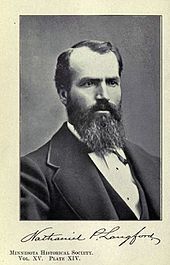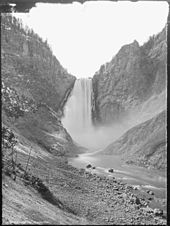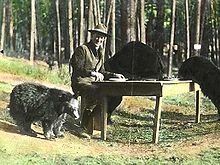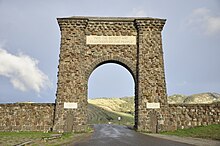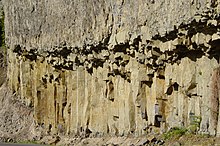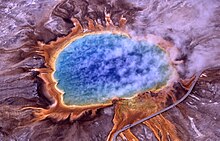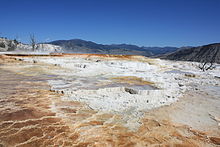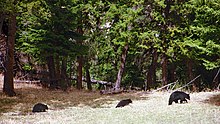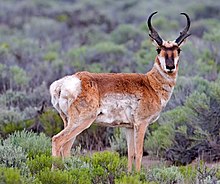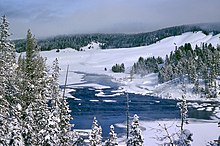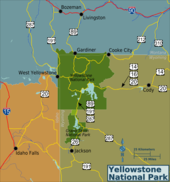From Wikipedia, the free encyclopedia
Yellowstone National Park is a
national park located in the
U.S. states of
Wyoming,
Montana, and
Idaho. It was established by the
U.S. Congress and signed into law by President
Ulysses S. Grant on March 1, 1872.
[4][5] Yellowstone was the first National Park in the U.S. and is also widely held to be the first national park in the world.
[6] The park is known for its wildlife and its many
geothermal features, especially
Old Faithful Geyser, one of its most popular features.
[7] It has many types of
ecosystems, but the
subalpine forest is the most abundant. It is part of the
South Central Rockies forests ecoregion.
Native Americans have lived in the Yellowstone region for at least 11,000 years.
[8] Aside from visits by
mountain men
during the early-to-mid-19th century, organized exploration did not
begin until the late 1860s. Management and control of the park
originally fell under the jurisdiction of the
Secretary of the Interior, the first being
Columbus Delano. However, the
U.S. Army was subsequently commissioned to oversee management of Yellowstone for a 30-year period between 1886 and 1916.
[9] In 1917, administration of the park was transferred to the
National Park Service,
which had been created the previous year. Hundreds of structures have
been built and are protected for their architectural and historical
significance, and researchers have examined more than 1,000
archaeological sites.
Yellowstone National Park spans an area of 3,468.4 square miles (8,983 km
2),
[1] comprising lakes, canyons, rivers and
mountain ranges.
[7] Yellowstone Lake is one of the largest high-elevation lakes in North America and is centered over the
Yellowstone Caldera, the largest
supervolcano on the continent. The
caldera is considered an active volcano. It has erupted with tremendous force several times in the last two million years.
[10] Half of the world's geothermal features are in Yellowstone, fueled by this ongoing volcanism.
[11] Lava flows and rocks from volcanic eruptions cover most of the land area of Yellowstone. The park is the centerpiece of the
Greater Yellowstone Ecosystem, the largest remaining nearly-intact ecosystem in the Earth's northern temperate zone.
[12]
Hundreds of species of mammals, birds, fish, and reptiles have been documented, including several that are either
endangered or
threatened.
[7] The vast forests and grasslands also include unique species of plants. Yellowstone Park is the largest and most famous
megafauna location in the
Continental United States.
Grizzly bears,
wolves, and free-ranging herds of
bison and
elk live in the park. The
Yellowstone Park bison herd is the oldest and largest public bison herd in the United States.
Forest fires occur in the park each year; in the
large forest fires of 1988, nearly one third of the park was burnt. Yellowstone has numerous recreational opportunities, including hiking,
camping,
boating,
fishing and sightseeing. Paved roads provide close access to the major
geothermal areas as well as some of the lakes and waterfalls. During the
winter, visitors often access the park by way of guided tours that use
either
snow coaches or
snowmobiles.
History
Detailed pictorial map from 1904
Share of the Yellowstone Park Association, issued 10 May 1889
The park contains the headwaters of the
Yellowstone River, from which it takes its historical name. Near the end of the 18th century,
French trappers named the river
Roche Jaune, which is probably a translation of the
Hidatsa name
Mi tsi a-da-zi ("Rock Yellow River").
[13]
Later, American trappers rendered the French name in English as "Yellow
Stone". Although it is commonly believed that the river was named for
the yellow rocks seen in the
Grand Canyon of the Yellowstone, the Native American name source is unclear.
[14]
The human history of the park begins at least 11,000 years ago when
Native Americans began to hunt and fish in the region. During the
construction of the post office in
Gardiner, Montana, in the 1950s, an
obsidian projectile point of
Clovis origin was found that dated from approximately 11,000 years ago.
[15] These
Paleo-Indians, of the Clovis culture, used the significant amounts of obsidian found in the park to make
cutting tools and
weapons.
Arrowheads made of Yellowstone obsidian have been found as far away as the
Mississippi Valley, indicating that a regular obsidian trade existed between local tribes and tribes farther east.
[16] By the time
white explorers first entered the region during the
Lewis and Clark Expedition in 1805, they encountered the
Nez Perce,
Crow, and
Shoshone
tribes. While passing through present day Montana, the expedition
members heard of the Yellowstone region to the south, but they did not
investigate it.
[16]
In 1806,
John Colter, a member of the
Lewis and Clark Expedition,
left to join a group of fur trappers. After splitting up with the other
trappers in 1807, Colter passed through a portion of what later became
the park, during the winter of 1807–1808. He observed at least one
geothermal area in the northeastern section of the park, near
Tower Fall.
[17] After surviving wounds he suffered in a battle with members of the Crow and
Blackfoot tribes in 1809, Colter described a place of "
fire and brimstone" that most people dismissed as delirium; the supposedly imaginary place was nicknamed "
Colter's Hell". Over the next 40 years, numerous reports from mountain men and trappers told of boiling mud, steaming rivers, and
petrified trees, yet most of these reports were believed at the time to be myth.
[18]
After an 1856 exploration, mountain man
Jim Bridger (also believed to be the first or second European American to have seen the
Great Salt Lake)
reported observing boiling springs, spouting water, and a mountain of
glass and yellow rock. These reports were largely ignored because
Bridger was a known "spinner of yarns". In 1859, a U.S. Army Surveyor
named Captain
William F. Raynolds embarked on a
two-year survey of the northern Rockies. After wintering in Wyoming, in May 1860, Raynolds and his party – which included naturalist
Ferdinand Vandeveer Hayden and guide Jim Bridger – attempted to cross the
Continental Divide over
Two Ocean Plateau from the
Wind River
drainage in northwest Wyoming. Heavy spring snows prevented their
passage, but had they been able to traverse the divide, the party would
have been the first organized survey to enter the Yellowstone region.
[19] The
American Civil War hampered further organized explorations until the late 1860s.
[20]
Ferdinand V. Hayden (1829–1887) American geologist who convinced Congress to make Yellowstone a National Park in 1872.
The first detailed expedition to the Yellowstone area was the
Cook–Folsom–Peterson Expedition
of 1869, which consisted of three privately funded explorers. The
Folsom party followed the Yellowstone River to Yellowstone Lake.
[21]
The members of the Folsom party kept a journal and based on the
information it reported, a party of Montana residents organized the
Washburn-Langford-Doane Expedition in 1870. It was headed by the surveyor-general of Montana
Henry Washburn, and included
Nathaniel P. Langford (who later became known as "National Park" Langford) and a U.S. Army detachment commanded by Lt.
Gustavus Doane.
The expedition spent about a month exploring the region, collecting
specimens and naming sites of interest. A Montana writer and lawyer
named Cornelius Hedges, who had been a member of the Washburn
expedition, proposed that the region should be set aside and protected
as a national park; he wrote detailed articles about his observations
for the
Helena Herald newspaper between 1870 and 1871. Hedges
essentially restated comments made in October 1865 by acting Montana
Territorial Governor
Thomas Francis Meagher, who had previously commented that the region should be protected.
[22] Others made similar suggestions. In an 1871 letter from
Jay Cooke to Ferdinand V. Hayden, Cooke wrote that his friend, Congressman
William D. Kelley had also suggested "
Congress pass a bill reserving the Great Geyser Basin as a public park forever".
[23]
Park creation

Ferdinand V. Hayden's map of Yellowstone National Park, 1871
In 1871, eleven years after his failed first effort,
Ferdinand V. Hayden
was finally able to explore the region. With government sponsorship, he
returned to the region with a second, larger expedition, the
Hayden Geological Survey of 1871. He compiled a comprehensive report, including large-format photographs by
William Henry Jackson and paintings by
Thomas Moran. The report helped to convince the U.S. Congress to withdraw this region from
public auction. On March 1, 1872, President
Ulysses S. Grant signed
The Act of Dedication[5] law that created Yellowstone National Park.
[24]
Hayden, while not the only person to have thought of creating a park
in the region, was its first and most enthusiastic advocate.
[25]
He believed in "setting aside the area as a pleasure ground for the
benefit and enjoyment of the people" and warned that there were those
who would come and "make merchandise of these beautiful specimens".
[25] Worrying the area could face the same fate as
Niagara Falls, he concluded the site should "be as free as the air or Water."
[25]
In his report to the Committee on Public Lands, he concluded that if
the bill failed to become law, "the vandals who are now waiting to enter
into this wonder-land, will in a single season despoil, beyond
recovery, these remarkable curiosities, which have required all the
cunning skill of nature thousands of years to prepare".
[26][27]
Hayden and his 1871 party recognized Yellowstone as a priceless
treasure that would become rarer with time. He wished for others to see
and experience it as well. Eventually the railroads and, some time after
that, the automobile would make that possible. The Park was not set
aside strictly for ecological purposes; however, the designation
"pleasure ground" was not an invitation to create an amusement park.
Hayden imagined something akin to the scenic resorts and baths in
England, Germany, and Switzerland.
[25]
THE ACT OF DEDICATION[27]
AN ACT to set apart a certain tract of land lying near the
headwaters of the Yellowstone River as a public park. Be it enacted by
the Senate and House of Representatives of the United States of America
in Congress assembled, That the tract of land in the Territories of
Montana and Wyoming ... is hereby reserved and withdrawn from
settlement, occupancy, or sale under the laws of the United States, and
dedicated and set apart as a public park or pleasuring ground for the
benefit and enjoyment of the people; and all persons who shall locate,
or settle upon, or occupy the same or any part thereof, except as
hereinafter provided, shall be considered trespassers and removed there
from ...
Approved March 1, 1872.
Signed by:
(1870) Portrait of Nathaniel P. Langford, the first superintendent of the park
[28]
There was considerable local opposition to the Yellowstone National
Park during its early years. Some of the locals feared that the regional
economy would be unable to thrive if there remained strict federal
prohibitions against resource development or settlement within park
boundaries and local entrepreneurs advocated reducing the size of the
park so that mining, hunting, and logging activities could be developed.
[29]
To this end, numerous bills were introduced into Congress by Montana
representatives who sought to remove the federal land-use restrictions.
[30]
After the park's official formation, Nathaniel Langford was appointed
as the park's first superintendent in 1872 by Secretary of Interior
Columbus Delano.
Langford served for five years but was denied a salary, funding, and
staff. Langford lacked the means to improve the land or properly protect
the park, and without formal policy or regulations, he had few legal
methods to enforce such protection. This left Yellowstone vulnerable to
poachers, vandals, and others seeking to raid its resources. He
addressed the practical problems park administrators faced in the 1872
Report to the Secretary of the Interior
[31]
and correctly predicted that Yellowstone would become a major
international attraction deserving the continuing stewardship of the
government. In 1874, both Langford and Delano advocated the creation of a
federal agency to protect the vast park, but Congress refused. In 1875,
Colonel
William Ludlow, who had previously explored areas of Montana under the command of
George Armstrong Custer,
was assigned to organize and lead an expedition to Montana and the
newly established Yellowstone Park. Observations about the lawlessness
and exploitation of park resources were included in Ludlow's
Report of a Reconnaissance to the Yellowstone National Park. The report included letters and attachments by other expedition members, including naturalist and mineralogist
George Bird Grinnell.
Great Falls of the Yellowstone", U.S. Geological and Geographic Survey
of the Territories (1874–1879) Photographer: William Henry Jackson
Grinnell documented the poaching of buffalo, deer, elk, and antelope
for hides. "It is estimated that during the winter of 1874–1875, not
less than 3,000 buffalo and mule deer suffer even more severely than the
elk, and the antelope nearly as much."
[32]
As a result, Langford was forced to step down in 1877.
[33][34] Having traveled through Yellowstone and witnessed land management problems first hand,
Philetus Norris
volunteered for the position following Langford's exit. Congress
finally saw fit to implement a salary for the position, as well as to
provide a minimal funding to operate the park. Norris used these funds
to expand access to the park, building numerous crude roads and
facilities.
[34]
In 1880,
Harry Yount
was appointed as a gamekeeper to control poaching and vandalism in the
park. Yount had previously spent decades exploring the mountain country
of present-day Wyoming, including the
Grand Tetons, after joining
F V. Hayden's Geological Survey in 1873.
[35] Yount is the first national park ranger,
[36] and Yount's Peak, at the head of the Yellowstone River, was named in his honor.
[37]
However, these measures still proved to be insufficient in protecting
the park, as neither Norris, nor the three superintendents who followed,
were given sufficient manpower or resources.
Fort Yellowstone, formerly a U.S. Army post, now serves as park headquarters.
The
Northern Pacific Railroad built a train station in
Livingston, Montana, connecting to the northern entrance in the early 1880s, which helped to increase visitation from 300 in 1872 to 5,000 in 1883.
[38] Visitors in these early years faced poor roads and limited services, and most access into the park was on horse or via
stagecoach. By 1908 visitation increased enough to attract a
Union Pacific Railroad connection to West Yellowstone, though rail visitation fell off considerably by
World War II
and ceased around the 1960s. Much of the railroad line was converted to
nature trails, among them the Yellowstone Branch Line Trail.
Thomas Moran painted Tower Creek, Yellowstone, while on the Hayden Geological Survey of 1871
During the 1870s and 1880s Native American tribes were effectively
excluded from the national park. Under a half-dozen tribes had made
seasonal use of the Yellowstone area, but the only year-round residents
were small bands of
Eastern Shoshone known as "
Sheepeaters".
They left the area under the assurances of a treaty negotiated in 1868,
under which the Sheepeaters ceded their lands but retained the right to
hunt in Yellowstone. The United States never ratified the treaty and
refused to recognize the claims of the Sheepeaters or any other tribe
that had used Yellowstone.
[39]
The
Nez Perce band associated with
Chief Joseph,
numbering about 750 people, passed through Yellowstone National Park in
thirteen days during late August 1877. They were being pursued by the
U.S. Army and entered the national park about two weeks after the
Battle of the Big Hole.
Some of the Nez Perce were friendly to the tourists and other people
they encountered in the park; some were not. Nine park visitors were
briefly taken captive. Despite Joseph and other chiefs ordering that no
one should be harmed, at least two people were killed and several
wounded.
[40][41] One of the areas where encounters occurred was in Lower Geyser Basin and east along a branch of the
Firehole River to Mary Mountain and beyond.
[40] That stream is still known as Nez Perce Creek.
[42] A group of
Bannocks entered the park in 1878, alarming park Superintendent
Philetus Norris. In the aftermath of the
Sheepeater Indian War of 1879, Norris built a fort to prevent Native Americans from entering the national park.
[39][41]
Ongoing poaching and destruction of natural resources continued unabated until the U.S. Army arrived at
Mammoth Hot Springs
in 1886 and built Camp Sheridan. Over the next 22 years the army
constructed permanent structures, and Camp Sheridan was renamed
Fort Yellowstone.
[43] On May 7, 1894, the
Boone and Crockett Club, acting through the personality of George G. Vest, Arnold Hague, William Hallett Phillips, W. A. Wadsworth, Archibald Rogers,
Theodore Roosevelt, and
George Bird Grinnell were successful in carrying through the Park Protection Act, which so saved the Park.
[44]
The Lacey Act of 1900 provided legal support for the officials
prosecuting poachers. With the funding and manpower necessary to keep a
diligent watch, the army developed their own policies and regulations
that permitted public access while protecting park wildlife and natural
resources. When the National Park Service was created in 1916, many of
the management principles developed by the army were adopted by the new
agency.
[43] The army turned control over to the National Park Service on October 31, 1918.
[45]
In 1898, the naturalist
John Muir
described the park as follows: "However orderly your excursions or
aimless, again and again amid the calmest, stillest scenery you will be
brought to a standstill hushed and awe-stricken before phenomena wholly
new to you. Boiling springs and huge deep pools of purest green and
azure water, thousands of them, are plashing and heaving in these high,
cool mountains as if a fierce furnace fire were burning beneath each one
of them; and a hundred geysers, white torrents of boiling water and
steam, like inverted waterfalls, are ever and anon rushing up out of the
hot, black underworld."
[46]
Later history
Park Superintendent Horace M. Albright and dinner guests, 1922. The
feeding of "tame" black bears was popular with tourists in the early
days of the park, but led to 527 injuries between 1931 and 1939.
[47]
By 1915, 1,000 automobiles per year were entering the park, resulting
in conflicts with horses and horse-drawn transportation. Horse travel
on roads was eventually prohibited.
[48]
The
Civilian Conservation Corps (CCC), a
New Deal
relief agency for young men, played a major role between 1933 and 1942
in developing Yellowstone facilities. CCC projects included
reforestation, campground development of many of the park's trails and
campgrounds, trail construction, fire hazard reduction, and
fire-fighting work. The CCC built the majority of the early visitor
centers, campgrounds and the current system of park roads.
[49]
During
World War II, tourist travel fell sharply, staffing was cut, and many facilities fell into disrepair.
[50]
By the 1950s, visitation increased tremendously in Yellowstone and
other national parks. To accommodate the increased visitation, park
officials implemented
Mission 66,
an effort to modernize and expand park service facilities. Planned to
be completed by 1966, in honor of the 50th anniversary of the founding
of the National Park Service, Mission 66 construction diverged from the
traditional log cabin style with design features of a modern style.
[51]
During the late 1980s, most construction styles in Yellowstone reverted
to the more traditional designs. After the enormous forest fires of
1988 damaged much of Grant Village, structures there were rebuilt in the
traditional style. The visitor center at Canyon Village, which opened
in 2006, incorporates a more traditional design as well.
[52]
The
Roosevelt Arch is located in Gardiner, Montana at the North Entrance
The
1959 Hebgen Lake earthquake just west of Yellowstone at
Hebgen Lake
damaged roads and some structures in the park. In the northwest section
of the park, new geysers were found, and many existing hot springs
became turbid.
[53] It was the most powerful earthquake to hit the region in recorded history.
In 1963, after several years of public controversy regarding the
forced reduction of the elk population in Yellowstone, United States
Secretary of the Interior
Stewart Udall
appointed an advisory board to collect scientific data to inform future
wildlife management of the national parks. In a paper known as the
Leopold Report,
the committee observed that culling programs at other national parks
had been ineffective, and recommended management of Yellowstone's elk
population.
[54]
The
wildfires
during the summer of 1988 were the largest in the history of the park.
Approximately 793,880 acres (321,272 ha; 1,240 sq mi) or 36% of the
parkland was impacted by the fires, leading to a systematic
re-evaluation of fire management policies. The fire season of 1988 was
considered normal until a combination of drought and heat by mid-July
contributed to an extreme fire danger. On "Black Saturday", August 20,
1988, strong winds expanded the fires rapidly, and more than 150,000
acres (61,000 ha; 230 sq mi) burned.
[55]
The expansive cultural history of the park has been documented by the 1,000
archeological sites that have been discovered. The park has 1,106
historic structures and features, and of these
Obsidian Cliff and five buildings have been designated
National Historic Landmarks.
[7] Yellowstone was designated an
International Biosphere Reserve on October 26, 1976, and a UN
World Heritage Site on September 8, 1978. The park was placed on the
List of World Heritage in Danger from 1995 to 2003 due to the effects of tourism, infection of wildlife, and issues with
invasive species.
[56] In 2010, Yellowstone National Park was honored with its own
quarter under the America the Beautiful Quarters Program.
[57]
Justin Ferrell explores three moral sensibilities that motivated
activists in dealing with Yellowstone. First came the utilitarian vision
of maximum exploitation of natural resources, characteristic of
developers in the late 19th century. Second was the spiritual vision of
nature inspired by the Romanticism and the transcendentalists the
mid-19th century. The twentieth century saw the biocentric moral vision
that focuses on the health of the ecosystem as theorized by
Aldo Leopold, which led to the expansion of federally protected areas and to the surrounding ecosystems.
[58]
Heritage and Research Center
The Heritage and Research Center is located at
Gardiner, Montana, near the north entrance to the park.
[59]
The center is home to the Yellowstone National Park's museum
collection, archives, research library, historian, archeology lab, and
herbarium.
The Yellowstone National Park Archives maintain collections of
historical records of Yellowstone and the National Park Service. The
collection includes the administrative records of Yellowstone, as well
as resource management records, records from major projects, and donated
manuscripts and personal papers. The archives are affiliated with the
National Archives and Records Administration.
[60][61]
Geography
Approximately 96 percent of the land area of Yellowstone National Park is located within the state of Wyoming.
[7]
Another three percent is within Montana, with the remaining one percent
in Idaho. The park is 63 miles (101 km) north to south, and 54 miles
(87 km) west to east by air. Yellowstone is 2,219,789 acres (898,317 ha;
3,468.420 sq mi)
[1] in area, larger than the states of
Rhode Island or
Delaware.
Rivers and lakes cover five percent of the land area, with the largest
water body being Yellowstone Lake at 87,040 acres (35,220 ha;
136.00 sq mi). Yellowstone Lake is up to 400 feet (120 m) deep and has
110 miles (180 km) of shoreline. At an elevation of 7,733 feet (2,357 m)
above sea level, Yellowstone Lake is the largest high altitude lake in
North America. Forests comprise 80 percent of the land area of the park;
most of the rest is
grassland.
[7]
The
Continental Divide of North America runs diagonally through the southwestern part of the park. The divide is a
topographic
feature that separates Pacific Ocean and Atlantic Ocean water
drainages. About one third of the park lies on the west side of the
divide. The origins of the Yellowstone and
Snake Rivers
are near each other but on opposite sides of the divide. As a result,
the waters of the Snake River flow to the Pacific Ocean, while those of
the Yellowstone find their way to the Atlantic Ocean via the
Gulf of Mexico.
Aerial view, 3D computer generated image
The park sits on the
Yellowstone Plateau, at an average elevation of 8,000 feet (2,400 m) above sea level. The plateau is bounded on nearly all sides by
mountain ranges of the
Middle Rocky Mountains, which range from 9,000 to 11,000 feet (2,700 to 3,400 m) in elevation. The highest point in the park is atop
Eagle Peak (11,358 feet or 3,462 metres) and the lowest is along Reese Creek (5,282 feet or 1,610 metres).
[7] Nearby mountain ranges include the
Gallatin Range to the northwest, the
Beartooth Mountains in the north, the
Absaroka Range to the east, and the
Teton Range and the
Madison Range to the southwest and west. The most prominent summit on the Yellowstone Plateau is
Mount Washburn at 10,243 feet (3,122 m).
Yellowstone National Park has one of the world's largest
petrified forests,
trees which were long ago buried by ash and soil and transformed from
wood to mineral materials. This ash and other volcanic debris are
believed to have come from the park area itself. This is largely because
Yellowstone is actually a massive caldera of a supervolcano. There are
290
waterfalls of at least 15 feet (4.6 m) in the park, the highest being the
Lower Falls of the Yellowstone River at 308 feet (94 m).
[7]
Three deep canyons are located in the park, cut through the volcanic
tuff of the Yellowstone Plateau by rivers over the last 640,000 years.
The
Lewis River flows through
Lewis Canyon in the south, and the
Yellowstone River has carved two colorful canyons, the
Grand Canyon of the Yellowstone and the Black Canyon of the Yellowstone in its journey north.
Geology
History
Columnar basalt near Tower Falls; large floods of basalt and other lava
types preceded mega-eruptions of superheated ash and pumice
Yellowstone is at the northeastern end of the
Snake River Plain, a great U-shaped arc through the mountains that extends from
Boise, Idaho some 400 miles (640 km) to the west. This feature traces the route of the
North American Plate over the last 17 million years as it was transported by
plate tectonics across a stationary
mantle hotspot. The landscape of present-day Yellowstone National Park is the most recent manifestation of this
hotspot below the
crust of the Earth.
[62]
The
Yellowstone Caldera is the largest volcanic system in North America. It has been termed a "
supervolcano" because the caldera was formed by exceptionally large explosive eruptions. The
magma chamber
that lies under Yellowstone is estimated to be a single connected
chamber, about 37 miles (60 km) long, 18 miles (29 km) wide, and 3 to 7
miles (5 to 12 km) deep.
[63] The current
caldera
was created by a cataclysmic eruption that occurred 640,000 years ago,
which released more than 240 cubic miles (1,000 km³) of ash, rock and
pyroclastic materials.
[64] This eruption was more than 1,000 times larger than the
1980 eruption of Mount St. Helens.
[65] It produced a caldera nearly five eighths of a mile (1 km) deep and 45 by 28 miles (72 by 45 km) in area and deposited the
Lava Creek Tuff, a
welded tuff geologic formation.
The most violent known eruption, which occurred 2.1 million years ago,
ejected 588 cubic miles (2,450 km³) of volcanic material and created the
rock formation known as the
Huckleberry Ridge Tuff and created the
Island Park Caldera.
[66] A smaller eruption ejected 67 cubic miles (280 km³) of material 1.3 million years ago, forming the
Henry's Fork Caldera and depositing the
Mesa Falls Tuff.
[65]
Each of the three climactic eruptions released vast amounts of ash
that blanketed much of central North America, falling many hundreds of
miles away. The amount of ash and gases released into the atmosphere
probably caused significant impacts to world weather patterns and led to
the
extinction of some species, primarily in North America.
[67]
A subsequent caldera-forming eruption occurred about 160,000 years
ago. It formed the relatively small caldera that contains the
West Thumb
of Yellowstone Lake. Since the last supereruption, a series of smaller
eruptive cycles between 640,000 and 70,000 years ago, has nearly filled
in the Yellowstone Caldera with 80 different eruptions of
rhyolitic lavas such as those that can be seen at
Obsidian Cliffs and
basaltic lavas which can be viewed at
Sheepeater Cliff.
Lava strata are most easily seen at the Grand Canyon of the
Yellowstone, where the Yellowstone River continues to carve into the
ancient lava flows. The canyon is a classic
V-shaped valley, indicative of river-type erosion rather than erosion caused by
glaciation.
[66]
Each eruption is part of an eruptive cycle that climaxes with the
partial collapse of the roof of the volcano's partially emptied magma
chamber. This creates a collapsed depression, called a caldera, and
releases vast amounts of volcanic material, usually through fissures
that ring the caldera. The time between the last three cataclysmic
eruptions in the Yellowstone area has ranged from 600,000 to
800,000 years, but the small number of such climactic eruptions cannot
be used to make an accurate prediction for future volcanic events.
[68]
Geysers and the hydrothermal system
Old Faithful Geyser erupts approximately every 91 minutes.
The most famous
geyser in the park, and perhaps the world, is
Old Faithful Geyser, located in
Upper Geyser Basin.
Castle Geyser,
Lion Geyser and
Beehive Geyser are in the same basin. The park contains the largest active geyser in the world—
Steamboat Geyser in the
Norris Geyser Basin.
A study that was completed in 2011 found that at least 1283 geysers
have erupted in Yellowstone. Of these, an average of 465 are active in a
given year.
[69][70]
Yellowstone contains at least 10,000 geothermal features altogether.
Half the geothermal features and two-thirds of the world's geysers are
concentrated in Yellowstone.
[71]
In May 2001, the
U.S. Geological Survey, Yellowstone National Park, and the
University of Utah
created the Yellowstone Volcano Observatory (YVO), a partnership for
long-term monitoring of the geological processes of the Yellowstone
Plateau volcanic field, for disseminating information concerning the
potential hazards of this geologically active region.
[72]
Steamboat Geyser is the world's largest active geyser.
In 2003, changes at the Norris Geyser Basin resulted in the temporary closure of some trails in the basin. New
fumaroles
were observed, and several geysers showed enhanced activity and
increasing water temperatures. Several geysers became so hot that they
were transformed into purely steaming features; the water had become
superheated and they could no longer erupt normally.
[73]
This coincided with the release of reports of a multiple year United
States Geological Survey research project which mapped the bottom of
Yellowstone Lake and identified a structural dome that had uplifted at
some time in the past. Research indicated that these uplifts posed no
immediate threat of a volcanic eruption, since they may have developed
long ago, and there had been no temperature increase found near the
uplifts.
[74]
On March 10, 2004, a biologist discovered 5 dead bison which apparently
had inhaled toxic geothermal gases trapped in the Norris Geyser Basin
by a seasonal atmospheric inversion. This was closely followed by an
upsurge of earthquake activity in April 2004.
[75]
In 2006, it was reported that the Mallard Lake Dome and the Sour Creek
Dome— areas that have long been known to show significant changes in
their ground movement— had risen at a rate of 1.5 to 2.4 inches (3.8 to
6.1 cm) per year from mid–2004 through 2006. As of late 2007, the uplift
has continued at a reduced rate.
[76][77]
These events inspired a great deal of media attention and speculation
about the geologic future of the region. Experts responded to the
conjecture by informing the public that there was no increased risk of a
volcanic eruption in the near future.
[78] However, these changes demonstrate the dynamic nature of the Yellowstone hydrothermal system.
Earthquakes
Yellowstone experiences thousands of small earthquakes every year,
virtually all of which are undetectable to people. There have been six
earthquakes with at least
magnitude 6 or greater in historical times, including a the 7.5‑magnitude
Hebgen Lake earthquake which occurred just outside the northwest boundary of the park in 1959. This quake triggered a huge
landslide, which caused a partial dam collapse on
Hebgen Lake; immediately downstream, the
sediment from the landslide dammed the river and created a new lake, known as
Earthquake Lake.
Twenty-eight people were killed, and property damage was extensive in
the immediate region. The earthquake caused some geysers in the
northwestern section of the park to erupt, large cracks in the ground
formed and emitted steam, and some hot springs that normally have clear
water turned muddy.
[53] A 6.1‑magnitude earthquake struck inside the park on June 30, 1975, but damage was minimal.
Upper Terraces of Mammoth Hot Springs
For three months in 1985, 3,000 minor earthquakes were detected in
the northwestern section of the park, during what has been referred to
as an
earthquake swarm, and has been attributed to minor subsidence of the Yellowstone caldera.
[65]
Beginning on April 30, 2007, 16 small earthquakes with magnitudes up to
2.7 occurred in the Yellowstone Caldera for several days. These swarms
of earthquakes are common, and there have been 70 such swarms between
1983 and 2008.
[79]
In December 2008, over 250 earthquakes were measured over a four-day
span under Yellowstone Lake, the largest measuring a magnitude of 3.9.
[80] In January 2010, more than 250 earthquakes were detected over a two-day period.
[81]
Seismic activity in Yellowstone National Park continues and is reported
hourly by the Earthquake Hazards Program of the U.S. Geological Survey.
[82]
On March 30, 2014, a magnitude 4.8 earthquake struck almost the very
middle of Yellowstone near the Norris Basin at 6:34 am; reports
indicated no damage. This was the largest earthquake to hit the park
since February 22, 1980.
[83]
Biology and ecology

Meadow in Yellowstone National Park
Yellowstone National Park is the centerpiece of the 20 million acre/31,250 square-mile (8,093,712 ha/80,937 km
2) Greater Yellowstone Ecosystem, a region that includes
Grand Teton National Park, adjacent
National Forests and expansive
wilderness
areas in those forests. The ecosystem is the largest remaining
continuous stretch of mostly undeveloped pristine land in the
continental United States, considered the world's largest intact
ecosystem in the northern temperate zone.
[12] With the successful
wolf reintroduction
program, which began in the 1990s, virtually all the original faunal
species known to inhabit the region when white explorers first entered
the area can still be found there.
Flora
Over 1,700
species of trees and other
vascular plants are native to the park. Another 170 species are considered to be
exotic species and are non-native. Of the eight
conifer tree species documented,
Lodgepole Pine forests cover 80% of the total forested areas.
[7] Other conifers, such as
Subalpine Fir,
Engelmann Spruce,
Rocky Mountain Douglas-fir and
Whitebark Pine, are found in scattered groves throughout the park. As of 2007, the whitebark pine is threatened by a fungus known as
white pine blister rust;
however, this is mostly confined to forests well to the north and west.
In Yellowstone, about seven percent of the whitebark pine species have
been impacted with the fungus, compared to nearly complete infestations
in northwestern Montana.
[84] Quaking Aspen and
willows are the most common species of
deciduous
trees. The aspen forests have declined significantly since the early
20th century, but scientists at Oregon State University attribute recent
recovery of the aspen to the reintroduction of wolves which has changed
the grazing habits of local elk.
[85]
Yellowstone sand verbena are endemic to Yellowstone's lakeshores.
There are dozens of species of flowering plants that have been
identified, most of which bloom between the months of May and September.
[86] The
Yellowstone Sand Verbena
is a rare flowering plant found only in Yellowstone. It is closely
related to species usually found in much warmer climates, making the
sand verbena an enigma. The estimated 8,000 examples of this rare
flowering plant all make their home in the sandy soils on the shores of
Yellowstone Lake, well above the waterline.
[87]
In Yellowstone's hot waters, bacteria form mats of bizarre shapes
consisting of trillions of individuals. These bacteria are some of the
most primitive life forms on earth. Flies and other
arthropods
live on the mats, even in the middle of the bitterly cold winters.
Initially, scientists thought that microbes there gained sustenance only
from
sulfur. In 2005 researchers from the
University of Colorado at Boulder discovered that the sustenance for at least some of the diverse
hyperthermophilic species is
molecular hydrogen.
[88]
Thermus aquaticus is a
bacterium
found in the Yellowstone hot springs that produces an important enzyme
(Taq polymerase) that is easily replicated in the lab and is useful in
replicating
DNA as part of the
polymerase chain reaction
(PCR) process. The retrieval of these bacteria can be achieved with no
impact to the ecosystem. Other bacteria in the Yellowstone hot springs
may also prove useful to scientists who are searching for cures for
various diseases.
[89] In 2016, researchers from Uppsala University reported the discovery of a class of thermophiles,
Hadesarchaea,
in Yellowstone's Culex Basin. These organisms are capable of converting
carbon monoxide and water to carbon dioxide and oxygen.
[90][91]
Non-native plants sometimes threaten native species by using up
nutrient resources. Though exotic species are most commonly found in
areas with the greatest human visitation, such as near roads and at
major tourist areas, they have also spread into the backcountry.
Generally, most exotic species are controlled by pulling the plants out
of the soil or by spraying, both of which are time consuming and
expensive.
[92]
Fauna
Yellowstone is widely considered to be the finest
megafauna wildlife habitat in the
lower 48 states. There are almost 60 species of
mammals in the park, including the
gray wolf,
coyote, the
threatened Canadian lynx, and
grizzly bears.
[7] Other large mammals include the
bison (often referred to as buffalo),
black bear,
elk,
moose,
mule deer,
white-tailed deer,
mountain goat,
pronghorn,
bighorn sheep, and
cougar.
Bison graze near a hot spring.
The
Yellowstone Park bison herd is the largest public herd of
American bison
in the United States. The relatively large bison populations are a
concern for ranchers, who fear that the species can transmit
bovine diseases to their domesticated cousins. In fact, about half of Yellowstone's bison have been exposed to
brucellosis, a bacterial disease that came to North America with European cattle that may cause cattle to
miscarry.
The disease has little effect on park bison, and no reported case of
transmission from wild bison to domestic livestock has been filed.
However, the
Animal and Plant Health Inspection Service (APHIS) has stated that bison are the "likely source" of the spread of the disease in cattle in Wyoming and
North Dakota. Elk also carry the disease and are believed to have transmitted the infection to horses and cattle.
[93]
Bison once numbered between 30 and 60 million individuals throughout
North America, and Yellowstone remains one of their last strongholds.
Their populations had increased from less than 50 in the park in 1902 to
4,000 by 2003. The Yellowstone Park bison herd reached a peak in 2005
with 4,900 animals. Despite a summer estimated population of 4,700 in
2007, the number dropped to 3,000 in 2008 after a harsh winter and
controversial brucellosis management sending hundreds to slaughter.
[94]
The Yellowstone Park bison herd is believed to be one of only four free
roaming and genetically pure herds on public lands in North America.
The other three herds are the
Henry Mountains bison herd of
Utah, at
Wind Cave National Park in
South Dakota and in
Elk Island National Park in
Alberta.
[95]
Elk mother nursing her calf.
To combat the perceived threat of
brucellosis
transmission to cattle, national park personnel regularly harass bison
herds back into the park when they venture outside of the area's
borders. During the winter of 1996–97, the bison herd was so large that
1,079 bison that had exited the park were shot or sent to slaughter.
[93] Animal rights
activists argue that this is a cruel practice and that the possibility
for disease transmission is not as great as some ranchers maintain.
Ecologists point out that the bison are merely traveling to seasonal
grazing areas that lie within the Greater Yellowstone Ecosystem that
have been converted to cattle grazing, some of which are within National
Forests and are leased to private ranchers. APHIS has stated that with
vaccinations and other means, brucellosis can be eliminated from the
bison and elk herds throughout Yellowstone.
[93]
A reintroduced wolf in Yellowstone National Park
Starting in 1914, in an effort to protect elk populations, the U.S.
Congress appropriated funds to be used for the purposes of "destroying
wolves,
prairie dogs,
and other animals injurious to agriculture and animal husbandry" on
public lands. Park Service hunters carried out these orders, and by 1926
they had killed 136 wolves, and wolves were virtually eliminated from
Yellowstone.
[96] Further exterminations continued until the National Park Service ended the practice in 1935. With the passing of the
Endangered Species Act in 1973, the wolf was one of the first mammal species listed.
[96] After the wolves were extirpated from Yellowstone, the
coyote
then became the park's top canine predator. However, the coyote is not
able to bring down large animals, and the result of this lack of a top
predator on these populations was a marked increase in lame and sick
megafauna.
Bison in Yellowstone National Park
By the 1990s, the Federal government had reversed its views on wolves. In a controversial decision by the
U.S. Fish and Wildlife Service
(which oversees threatened and endangered species), northwestern wolves
imported from Canada were reintroduced into the park. Reintroduction
efforts have been successful with populations remaining relatively
stable. A survey conducted in 2005 reported that there were 13 wolf
packs, totaling 118 individuals in Yellowstone and 326 in the entire
ecosystem. These park figures were lower than those reported in 2004 but
may be attributable to wolf migration to other nearby areas as
suggested by the substantial increase in the Montana population during
that interval.
[97] Almost all the wolves documented were descended from the 66 wolves reintroduced in 1995–96.
[97]
The recovery of populations throughout the states of Wyoming, Montana
and Idaho has been so successful that on February 27, 2008, the U.S.
Fish and Wildlife Service removed the Northern Rocky Mountain wolf
population from the endangered species list.
[98]
Black bear and cubs in the Tower-Roosevelt area
An estimated 600 grizzly bears live in the Greater Yellowstone
Ecosystem, with more than half of the population living within
Yellowstone. The grizzly is currently listed as a threatened species,
however the U.S. Fish and Wildlife Service has announced that they
intend to take it off the endangered species list for the Yellowstone
region but will likely keep it listed in areas where it has not yet
recovered fully. Opponents of delisting the grizzly are concerned that
states might once again allow hunting and that better conservation
measures need to be implemented to ensure a sustainable population.
[99] Black bears
are common in the park and were a park symbol due to visitor
interaction with the bears starting in 1910. Feeding and close contact
with bears has not been permitted since the 1960s to reduce their desire
for human foods.
[100] Yellowstone is one of the few places in the United States where black bears can be seen coexisting with grizzly bears.
[100]
Black bear observations occur most often in the park's northern ranges
and in the Bechler area which is in the park's southwestern corner.
[101]
Population figures for elk are in excess of 30,000—the largest
population of any large mammal species in Yellowstone. The northern herd
has decreased enormously since the mid‑1990s; this has been attributed
to wolf predation and causal effects such as elk using more forested
regions to evade predation, consequently making it harder for
researchers to accurately count them.
[102]
The northern herd migrates west into southwestern Montana in the
winter. The southern herd migrates southward, and the majority of these
elk winter on the
National Elk Refuge,
immediately southeast of Grand Teton National Park. The southern herd
migration is the largest mammalian migration remaining in the U.S.
outside of Alaska.
Pronghorn are commonly found on the grasslands in the park.
In 2003 the tracks of one female lynx and her cub were spotted and
followed for over 2 miles (3.2 km). Fecal material and other evidence
obtained were tested and confirmed to be those of a lynx. No visual
confirmation was made, however. Lynx have not been seen in Yellowstone
since 1998, though
DNA taken from hair samples obtained in 2001 confirmed that lynx were at least transient to the park.
[103] Other less commonly seen mammals include the mountain lion and
wolverine. The mountain lion has an estimated population of only 25 individuals parkwide.
[104] The wolverine is another rare park mammal, and accurate population figures for this species are not known.
[105]
These uncommon and rare mammals provide insight into the health of
protected lands such as Yellowstone and help managers make
determinations as to how best to preserve habitats.
Eighteen species of fish live in Yellowstone, including the core range of the
Yellowstone cutthroat trout—a fish highly sought by
anglers.
[7][106]
The Yellowstone cutthroat trout has faced several threats since the
1980s, including the suspected illegal introduction into Yellowstone
Lake of
lake trout, an
invasive species which consume the smaller cutthroat trout.
[107] Although lake trout were established in
Shoshone and
Lewis
lakes in the Snake River drainage from U.S. Government stocking
operations in 1890, it was never officially introduced into the
Yellowstone River drainage.
[108] The cutthroat trout has also faced an ongoing drought, as well as the accidental introduction of a parasite—
whirling disease—which
causes a terminal nervous system disease in younger fish. Since 2001,
all native sport fish species caught in Yellowstone waterways are
subject to a catch and release law.
[106] Yellowstone is also home to six species of
reptiles, such as the
painted turtle and
Prairie rattlesnake, and four species of
amphibians, including the
Boreal Chorus Frog.
[109]
311 species of birds have been reported, almost half of which nest in Yellowstone.
[7] As of 1999, twenty-six pairs of nesting bald eagles have been documented. Extremely rare sightings of
whooping cranes
have been recorded, however only three examples of this species are
known to live in the Rocky Mountains, out of 385 known worldwide.
[110] Other birds, considered to be species of special concern because of their rarity in Yellowstone, include the
common loon,
harlequin duck,
osprey,
peregrine falcon and the
trumpeter swan.
[111]
Forest fires
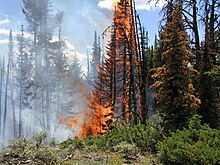
Fire in Yellowstone National Park
As
wildfire is a natural part of most ecosystems, plants that are
indigenous to Yellowstone have adapted in a variety of ways.
Douglas-fir have a thick bark which protects the inner section of the tree from most fires.
Lodgepole Pines
—the most common tree species in the park— generally have cones that
are only opened by the heat of fire. Their seeds are held in place by a
tough resin, and fire assists in melting the resin, allowing the seeds
to disperse. Fire clears out dead and downed wood, providing fewer
obstacles for lodgepole pines to flourish.
Subalpine Fir,
Engelmann Spruce,
Whitebark Pine, and other species tend to grow in colder and moister areas, where fire is less likely to occur.
Aspen
trees sprout new growth from their roots, and even if a severe fire
kills the tree above ground, the roots often survive unharmed because
they are insulated from the heat by soil.
[112]
The National Park Service estimates that in natural conditions,
grasslands in Yellowstone burned an average of every 20 to 25 years,
while forests in the park would experience fire about every 300 years.
[112]
About thirty-five natural forest fires are ignited each year by
lightning, while another six to ten are started by people— in most cases by accident. Yellowstone National Park has three
fire lookout towers,
each staffed by trained fire fighters. The easiest one to reach is atop
Mount Washburn, which has interpretive exhibits and an observation deck
open to the public.
[113] The park also monitors fire from the air and relies on visitor reports of smoke and/or flames.
[114]
Fire towers are staffed almost continuously from late June to
mid-September— the primary fire season. Fires burn with the greatest
intensity in the late afternoon and evening. Few fires burn more than
100 acres (40 ha), and the vast majority of fires reach only a little
over an acre (0.5 ha) before they burn themselves out.
[115]
Fire management focuses on monitoring dead and down wood quantities,
soil and tree moisture, and the weather, to determine those areas most
vulnerable to fire should one ignite. Current policy is to suppress all
human caused fires and to evaluate natural fires, examining the benefit
or detriment they may pose on the ecosystem. If a fire is considered to
be an immediate threat to people and structures, or will burn out of
control, then fire suppression is performed.
[116]
Wildfire in Yellowstone National Park produces a pyrocumulus cloud.
In an effort to minimize the chances of out of control fires and
threats to people and structures, park employees do more than just
monitor the potential for fire.
Controlled burns
are prescribed fires which are deliberately started to remove dead
timber under conditions which allow fire fighters an opportunity to
carefully control where and how much wood is consumed. Natural fires are
sometimes considered prescribed fires if they are left to burn. In
Yellowstone, unlike some other parks, there have been very few fires
deliberately started by employees as prescribed burns. However, over the
last 30 years, over 300 natural fires have been allowed to burn
naturally. In addition, fire fighters remove dead and down wood and
other hazards from areas where they will be a potential fire threat to
lives and property, reducing the chances of fire danger in these areas.
[117]
Fire monitors also regulate fire through educational services to the
public and have been known to temporarily ban campfires from campgrounds
during periods of high fire danger. The common notion in early United
States land management policies was that all forest fires were bad. Fire
was seen as a purely destructive force and there was little
understanding that it was an integral part of the ecosystem.
Consequently, until the 1970s, when a better understanding of wildfire
was developed, all fires were suppressed. This led to an increase in
dead and dying forests, which would later provide the fuel load for
fires that would be much harder, and in some cases, impossible to
control. Fire Management Plans were implemented, detailing that natural
fires should be allowed to burn if they posed no immediate threat to
lives and property.
A crown fire approaches the Old Faithful complex on September 7, 1988.
1988 started with a wet spring season although by summer, drought
began moving in throughout the northern Rockies, creating the driest
year on record to that point. Grasses and plants which grew well in the
early summer from the abundant spring moisture produced plenty of grass,
which soon turned to dry tinder. The National Park Service began
firefighting efforts to keep the fires under control, but the extreme
drought made suppression difficult. Between July 15 and 21, 1988, fires
quickly spread from 8,500 acres (3,400 ha; 13.3 sq mi) throughout the
entire Yellowstone region, which included areas outside the park, to
99,000 acres (40,000 ha; 155 sq mi) on the park land alone. By the end
of the month, the fires were out of control. Large fires burned
together, and on August 20, 1988, the single worst day of the fires,
more than 150,000 acres (61,000 ha; 230 sq mi) were consumed. Seven
large fires were responsible for 95% of the 793,000 acres (321,000 ha;
1,239 sq mi) that were burned over the next couple of months. A total of
25,000 firefighters and U.S. military forces participated in the
suppression efforts, at a cost of 120 million dollars. By the time
winter brought snow that helped extinguish the last flames, the fires
had destroyed 67 structures and caused several million dollars in
damage.
[55] Though no civilian lives were lost, two personnel associated with the firefighting efforts were killed.
Contrary to media reports and speculation at the time, the fires
killed very few park animals— surveys indicated that only about 345 elk
(of an estimated 40,000–50,000), 36 deer, 12 moose, 6 black bears, and 9
bison had perished. Changes in fire management policies were
implemented by land management agencies throughout the United States,
based on knowledge gained from the 1988 fires and the evaluation of
scientists and experts from various fields. By 1992, Yellowstone had
adopted a new fire management plan which observed stricter guidelines
for the management of natural fires.
[55]
Climate
Winter scene in Yellowstone
Yellowstone climate is greatly influenced by altitude, with lower
elevations generally found to be warmer year-round. The record high
temperature was 99 °F (37 °C) in 2002, while the coldest temperature
recorded is −66 °F (−54 °C) in 1933.
[7]
During the summer months of June through early September, daytime highs
are normally in the 70 to 80 °F (21 to 27 °C) range, while night time
lows can go to below freezing (0 °C) especially at higher altitudes.
Summer afternoons are frequently accompanied by
thunderstorms.
Spring and fall temperatures range between 30 and 60 °F (−1 and 16 °C)
with nights in the teens to single digits (−5 to −20 °C). Winter in
Yellowstone is accompanied by high temperatures usually between zero and
20 °F (−20 to −5 °C) and nighttime temperatures below 0 °F (−18 °C)
for most of the winter.
[118]
Precipitation in Yellowstone is highly variable and ranges from 15
inches (380 mm) annually near Mammoth Hot Springs, to 80 inches
(2,000 mm) in the southwestern sections of the park. The precipitation
of Yellowstone is greatly influenced by the moisture channel formed by
the
Snake River Plain
to the west that was, in turn, formed by Yellowstone itself. Snow is
possible in any month of the year, but most common between November and
April, with averages of 150 inches (3,800 mm) annually around
Yellowstone Lake, to twice that amount at higher elevations.
[118]
Tornadoes in Yellowstone are rare; however, on July 21, 1987, the most powerful tornado recorded in Wyoming touched down in the
Teton Wilderness of
Bridger-Teton National Forest and hit Yellowstone National Park. Called the
Teton–Yellowstone tornado, it was classified as an
F4,
with wind speeds estimated at between 207 and 260 miles per hour (333
and 418 km/h). The tornado left a path of destruction 1 to 2 miles (1.6
to 3.2 km) wide, and 24 miles (39 km) long, and leveled 15,000 acres
(6,100 ha; 23 sq mi) of mature pine forest.
[119]
The climate at Yellowstone Lake is classified as
subarctic (Dfc), according to
Köppen-Geiger climate classification, while at the park headquarters the classification is
humid continental (Dfb).
Recreation
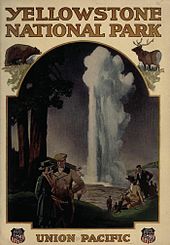
Union Pacific Railroad Brochure Promoting Travel to Park (1921)
Yellowstone ranks among the most popular national parks in the United
States. Since the mid-1960s, at least 2 million tourists have visited
the park almost every year.
[124]
Average annual visitation increased to 3.5 million during the ten-year
period from 2007 to 2016, with a record of 4,257,177 recreational
visitors in 2016.
[2] July is the busiest month for Yellowstone National Park.
[125]
At peak summer levels, 3,700 employees work for Yellowstone National
Park concessionaires. Concessionaires manage nine hotels and lodges,
with a total of 2,238 hotel rooms and cabins available. They also
oversee gas stations, stores and most of the campgrounds. Another 800
employees work either permanently or seasonally for the National Park
Service.
[7]
Park service roads lead to major features; however, road
reconstruction has produced temporary road closures. Yellowstone is in
the midst of a long term road reconstruction effort, which is hampered
by a short repair season. In the winter, all roads aside from the one
which enters from
Gardiner, Montana, and extends to
Cooke City, Montana, are closed to wheeled vehicles.
[126] Park roads are closed to wheeled vehicles from early November to mid April, but some park roads remain closed until mid-May.
[127] The park has 310 miles (500 km) of paved roads which can be accessed from five different entrances.
[7]
There is no public transportation available inside the park, but
several tour companies can be contacted for guided motorized transport.
In the winter, concessionaires operate guided
snowmobile and
snow coach tours, though their numbers and access are based on quotas established by the National Park Service.
[128]
Facilities in the Old Faithful, Canyon and Mammoth Hot Springs areas of
the park are very busy during the summer months. Traffic jams created
by road construction or by people observing wildlife can result in long
delays.
The National Park Service maintains 9 visitor centers and museums and
is responsible for maintenance of historical structures and many of the
other 2,000 buildings. These structures include National Historical
Landmarks such as the
Old Faithful Inn built from 1903 to 1904 and the entire
Fort Yellowstone – Mammoth Hot Springs Historic District.
An historical and educational tour is available at Fort Yellowstone
which details the history of the National Park Service and the
development of the park. Campfire programs, guided walks and other
interpretive presentations are available at numerous locations in the
summer, and on a limited basis during other seasons.
Camping is available at a dozen campgrounds with more than 2,000 campsites.
[7] Camping is also available in surrounding National Forests, as well as in Grand Teton National Park to the south.
Backcountry campsites are accessible only by foot or by
horseback and require a permit. There are 1,100 miles (1,800 km) of hiking trails available.
[129] The park is not considered to be a good destination for
mountaineering
because of the instability of volcanic rock which predominates.
Visitors with pets are required to keep them on a leash at all times and
are limited to areas near roadways and in "frontcountry" zones such as
drive in campgrounds.
[130]
Around thermal features, wooden and paved trails have been constructed
to ensure visitor safety, and most of these areas are handicapped
accessible. The National Park Service maintains a year-round clinic at
Mammoth Hot Springs and provides emergency services throughout the year.
[131]
Hunting is not permitted, though it is allowed in the surrounding
national forests during open season. Fishing is a popular activity, and a
Yellowstone Park fishing license is required to fish in park waters.
[132] Many park waters are
fly fishing only and all native fish species are
catch and release only.
[133] Boating is prohibited on rivers and creeks except for a 5 miles (8.0 km) stretch of the Lewis River between Lewis and
Shoshone Lake, and it is open to non-motorized use only. Yellowstone Lake has a marina, and the lake is the most popular boating destination.
[134]
Vintage photo of human-habituated bears seeking food from visitors.
In the early history of the park, visitors were allowed, and
sometimes even encouraged, to feed the bears. Visitors welcomed the
chance to get their pictures taken with the bears, who had learned to
beg for food. This led to numerous injuries to humans each year. In
1970, park officials changed their policy and started a vigorous program
to educate the public on the dangers of close contact with bears, and
to try to eliminate opportunities for bears to find food in campgrounds
and trash collection areas. Although it has become more difficult to
observe bears in recent years, the number of human injuries and deaths
has taken a significant drop and visitors are in less danger.
[135] The eighth recorded bear-related death in the park's history occurred in August 2015.
[136]
Other protected lands in the region include
Caribou-Targhee,
Gallatin,
Custer,
Shoshone and Bridger-Teton National Forests. The National Park Service's
John D. Rockefeller, Jr. Memorial Parkway is to the south and leads to Grand Teton National Park. The famed
Beartooth Highway provides access from the northeast and has spectacular high altitude scenery. Nearby communities include
West Yellowstone, Montana;
Cody, Wyoming;
Red Lodge, Montana;
Ashton, Idaho; and
Gardiner, Montana. The closest air transport is available by way of
Bozeman, Montana;
Billings, Montana;
Jackson;
Cody, Wyoming, or
Idaho Falls, Idaho.
[137] Salt Lake City, 320 miles (510 km) to the south, is the closest large metropolitan area.
Legal jurisdiction
Street map of Yellowstone National Park at the northwest corner of Wyoming
The entire park is within the jurisdiction of the
United States District Court for the District of Wyoming,
making it the only federal court district that includes portions of
more than one state (Idaho, Montana, and Wyoming). Law professor Brian
C. Kalt has argued that it may be impossible to impanel a jury in
compliance with the
Vicinage Clause of the
Sixth Amendment
for a crime committed solely in the unpopulated Idaho portion of the
park (and that it would be difficult to do so for a crime committed
solely in the lightly populated Montana portion).
[138]
One defendant, who was accused of a wildlife-related crime in the
Montana portion of the park, attempted to raise this argument but
eventually pleaded guilty.
[139][140]
is the thermal energy in joules
is the heat transfer coefficient (assumed independent of T here) (W/(m2 K))
is the heat transfer surface area (m2)
is the temperature of the object's surface and interior (since these are the same in this approximation)
is the temperature of the environment; i.e. the temperature suitably far from the surface
is the time-dependent thermal gradient between environment and object
 (total thermal energy content) which is proportional to
(total thermal energy content) which is proportional to  (simple total heat capacity) and
(simple total heat capacity) and  (the temperature of the body), then
(the temperature of the body), then  . It is expected that the system will experience exponential decay in the temperature difference of body and surroundings as a function of time. This is proven in the following sections:
. It is expected that the system will experience exponential decay in the temperature difference of body and surroundings as a function of time. This is proven in the following sections: comes the relation
comes the relation  .
Differentiating this equation with regard to time gives the identity
(valid so long as temperatures in the object are uniform at any given
time):
.
Differentiating this equation with regard to time gives the identity
(valid so long as temperatures in the object are uniform at any given
time):  . This expression may be used to replace
. This expression may be used to replace  in the first equation which begins this section, above. Then, if
in the first equation which begins this section, above. Then, if  is the temperature of such a body at time
is the temperature of such a body at time  , and
, and  is the temperature of the environment around the body:
is the temperature of the environment around the body: is a positive constant characteristic of the system, which must be in units of
is a positive constant characteristic of the system, which must be in units of  , and is therefore sometimes expressed in terms of a characteristic time constant
, and is therefore sometimes expressed in terms of a characteristic time constant  given by:
given by:  . Thus, in thermal systems,
. Thus, in thermal systems,  . (The total heat capacity
. (The total heat capacity  of a system may be further represented by its mass-specific heat capacity
of a system may be further represented by its mass-specific heat capacity  multiplied by its mass
multiplied by its mass  , so that the time constant
, so that the time constant  is also given by
is also given by  ).
).is defined as :
where
is the initial temperature difference at time 0,
 , as a single function of time to be found, or "solved for."
, as a single function of time to be found, or "solved for."










